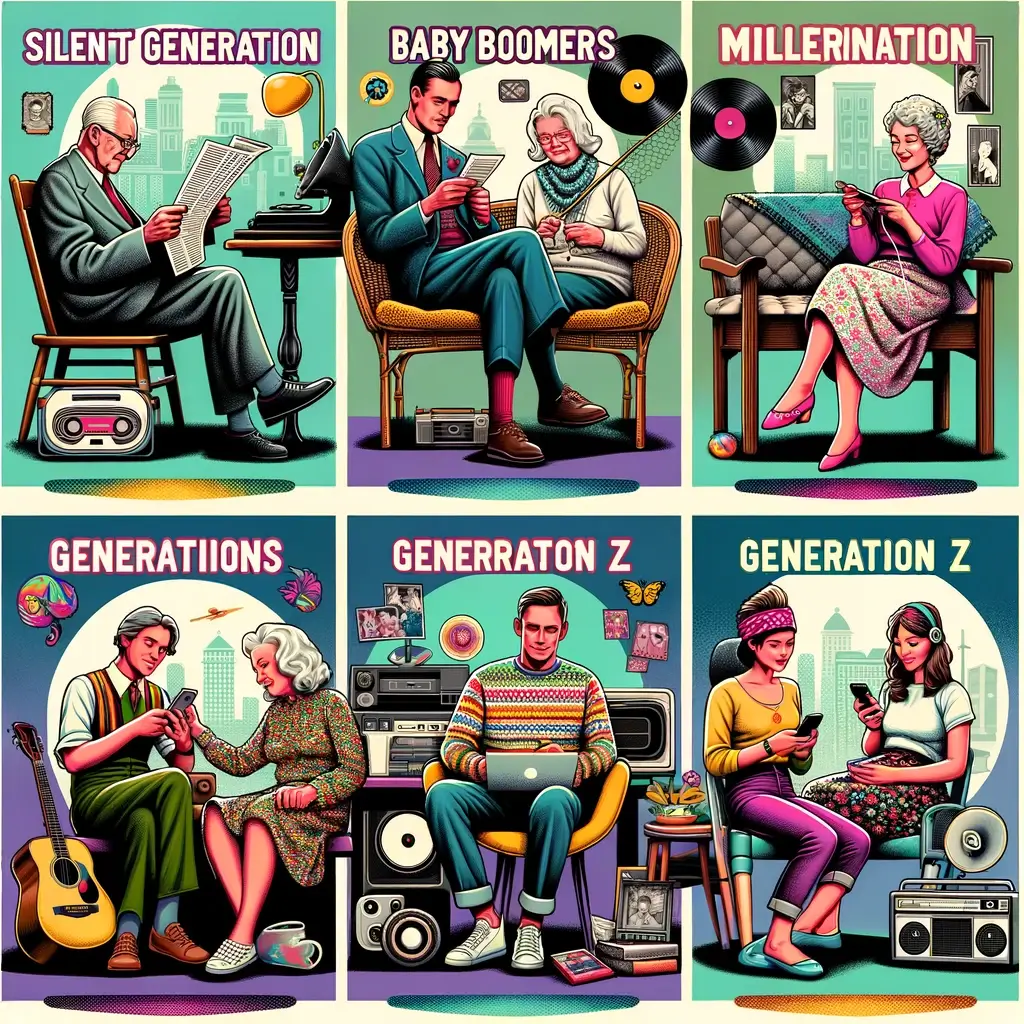Generational cohorts are a way of grouping people born during a similar period who often share certain characteristics, influenced by the socio-economic, political, and technological contexts of their formative years. Here are the commonly recognized generations, along with their defining characteristics:
1. The Silent Generation (1928-1945)
• Defining Characteristics:
• Traditional Values: Emphasize hard work, discipline, and conformity.
• Loyalty: Strong loyalty to their employers and a preference for stability and long-term careers.
• Frugality: Influenced by the Great Depression and World War II, tend to be conservative with finances.
• Technological Adaptation: Generally less comfortable with technology compared to younger generations but many have adapted due to necessity.
2. Baby Boomers (1946-1964)
• Defining Characteristics:
• Post-War Prosperity: Grew up during a time of economic growth and prosperity, often associated with optimism and opportunity.
• Work-Centric: Tends to define themselves through their careers; known for their strong work ethic.
• Social Change: Witnessed and often participated in significant social movements, including civil rights, women’s liberation, and anti-war protests.
• Consumerism: Marked by an inclination towards consumerism and the pursuit of the “American Dream.”
3. Generation X (1965-1980)
• Defining Characteristics:
• Independence: Often described as self-reliant and entrepreneurial.
• Work-Life Balance: Emphasizes the importance of work-life balance, reacting to the long work hours often seen in Baby Boomers.
• Technological Transition: Experienced the transition from analog to digital technology; often comfortable with both.
• Skeptical: Known for skepticism, particularly towards institutions and authority, influenced by events like Watergate and corporate downsizing.
4. Millennials (1981-1996) – also known as Generation Y
• Defining Characteristics:
• Digital Natives: Grew up during the rise of the internet, social media, and mobile technology.
• Value Experiences: Tend to prioritize experiences over material possessions.
• Diversity and Inclusion: Places a high value on diversity, inclusivity, and social consciousness.
• Education and Debt: Generally highly educated but often burdened by student debt.
• Work Preferences: Prefers flexible work environments and values work with purpose and meaning.
5. Generation Z (1997-2012)
• Defining Characteristics:
• True Digital Natives: Has grown up with smartphones, social media, and constant connectivity as a standard.
• Pragmatic and Financially Minded: Exhibits financial pragmatism, likely influenced by watching the effects of the Great Recession on their families.
• Socially Conscious: Highly aware of social, political, and environmental issues.
• Short Attention Spans: Often associated with shorter attention spans due to high exposure to fast-paced digital content.
• Independent Learning: Leverages online resources for self-education and skill-building.
6. Generation Alpha (2013-Present)
• Defining Characteristics:
• Tech Immersion: From birth, immersed in technology; AI, virtual reality, and advanced digital interfaces are expected parts of life.
• Highly Educated: Predicted to be the most formally educated generation, with education increasingly influenced by technology.
• Health and Well-being: Growing up with heightened awareness of health, wellness, and environmental sustainability.
• Global Perspective: Likely to have a more global perspective due to the internet making international connections easier and more common.
Inter-Generation Dynamics:
• Cultural Exchange:
• Different generations bring diverse perspectives and experiences to the table, which can lead to both conflict and innovation.
• Understanding these characteristics can improve communication, workplace dynamics, marketing strategies, and social policies.
Understanding and Utilizing Generational Characteristics:
• Communication Strategies:
• Tailor communication methods to suit different generational preferences—e.g., in-person meetings for Boomers, emails and texts for Gen X, instant messaging and social media for Millennials and Gen Z.
• Workplace Environment:
• Foster inclusive workplace environments where multiple generations can coexist, learn from each other, and leverage their unique strengths.
• Marketing and Customer Engagement:
• Develop targeted marketing strategies that resonate with each generation’s values, behaviors, and preferences.
By recognizing and acknowledging the unique characteristics and contributions of each generation, businesses, educators, politicians, and individuals can better navigate intergenerational dynamics and foster a more inclusive and productive environment.
